R&D Success: Enzyme assay for HbA1c

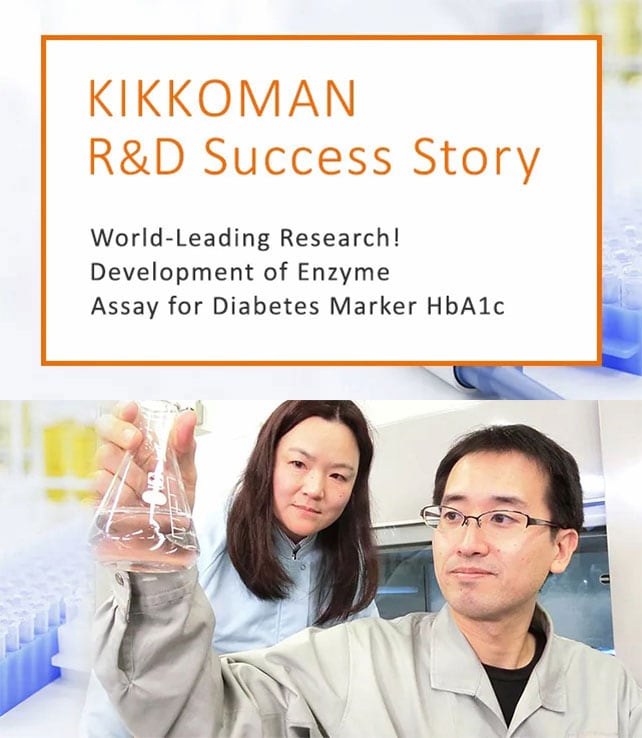
Implementing vital research for the diagnosis of diabetes!
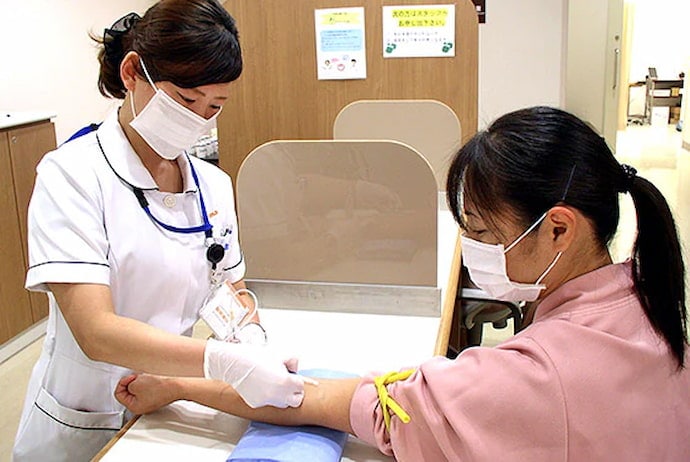
The number of diabetes patients is increasing worldwide. Serious complications will occur if diabetes is not detected and control of blood sugar levels is not initiated at an early stage of the disease. At Kikkoman, while we already had a track record of searching for novel enzymes in nature and putting these to industrial uses, we began to consider that this enzyme research might also have other applications. For example: If we developed a simpler enzyme assay, this could have applications in the diagnosis of diabetes, and contribute to alleviating the suffering of diabetes patients. We are embarking on this new endeavor to develop a new and improved assay with this thought in our hearts.
A new enzyme, central to the development of the new assay, discovered by Kikkoman
One of the indexes used in the diagnosis of diabetes is glycated hemoglobin (HbA1c) (1).
The measurement of HbA1c using enzymes is suitable for processing large numbers of specimens, and is cost efficient. As such, there has long been a strong call from health practitioners for the development of such an enzyme assay. While this worldwide scramble to develop an enzyme assay, we developed a new assay using the “dipeptide method”. Specifically, we discovered “Fructosyl-peptide Oxidase” (FPOX) (2) which could be used as an enzyme for this assay. This facilitated our success in achieving a world’s first by making a reality of an HbA1c enzyme assay.
This “dipeptide method” uses Protease (Proteolytic enzyme) to break down HbA1c in the bloodstream, and then measures the levels of saccharified dipeptides produced using FPOX.
This method met with an overwhelmingly positive reception due to its merits of being simple, inexpensive and speedy, and the HbA1c measuring reagent using FPOX manufactured and sold by a Kikkoman Group company has now come to be used throughout the world.
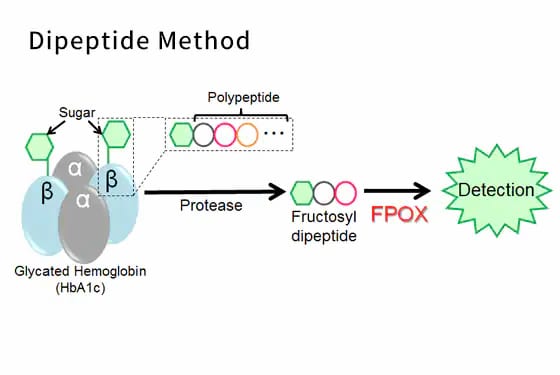

WHAT is glycated hemoglobin (HbA1c)?
Diabetes is diagnosed by means of a blood test, with the levels of blood glucose and glycated hemoglobin (HbA1c) being two of the indexes used. HbA1c is a component formed by the combination of hemoglobin in the blood with glucose, and it is said to form more easily when blood glucose levels are high. It is known that its levels reflect the average blood glucose levels for the previous one to two months. This index is used not just in the screening of diabetes but is also attracting attention as an index for diabetes management.

AND Just WHAT is “Fructosyl-peptide Oxidase” (FPOX)?
This is a new enzyme discovered by Kikkoman in its search for an enzyme which would react with saccharified dipeptides.
Towards even greater simplicity, economy and speed
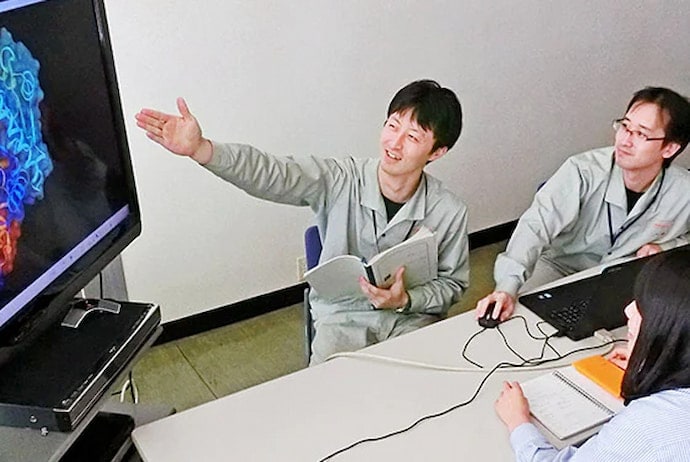
The HbA1c measuring kit using the dipeptide method is already being applied worldwide.
However, there have been calls for the test to be made even easier, cheaper and quicker. One thread pursued in the endeavor to address this need was to find an enzyme which reacts directly with HbA1c rather than using proteolysis, leading to the development of “A1c Oxidase” (3). We thus committed to developing a simple next-generation “direct method” measurement, using this novel enzyme.
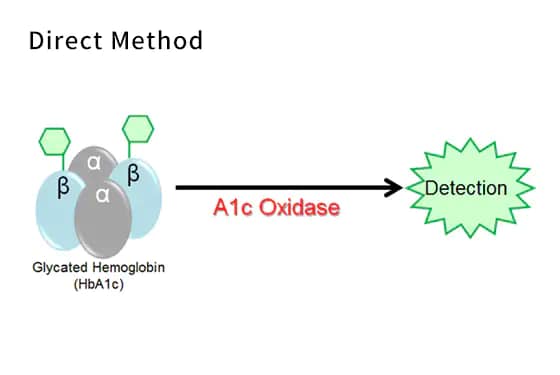

Exactly WHAT is A1c Oxidase?
HbA1c is a large protein molecule. Previously no enzyme existed which allowed its measurement by reacting directly with it.With this as our starting point we began - in collaboration with Kyoto University - precise analyses of the tertiary protein structure of FPOX which acts on glycated dipeptides. Using the results of this analysis we were able to engineer the enzyme so that it directly reacts with HbA1c. Thus, we successfully created a world’s first “A1c Oxidase”.
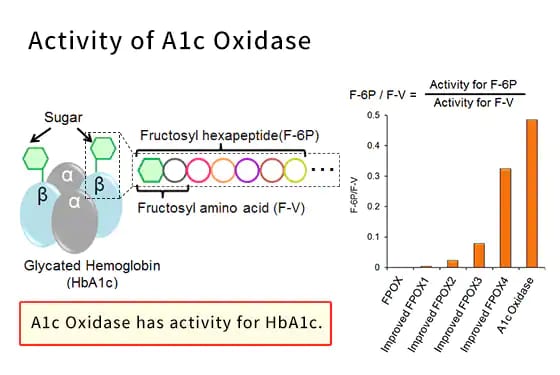
Seasoning your life

The onset of diabetes is inevitably accompanied by dietary restrictions.
Kikkoman’s corporate slogan is “seasoning your life”.
By proposing various ways to support healthy lifestyles through food and ways to prevent diabetes, we hope to continue to provide the support so that consumers can happily continue to season their lives.
This research was awarded the 2013 Japan Biotechnology Prize from the Society for Biotechnology, Japan; and was also selected as one of the topics at the Annual Meeting 2015 of that Society.
Coverage in external publications
Ichiyanagi, A., Hirokawa, K., Gomi, K., Nakatsu, T., Kato, H., & Kajiyama, N. (2013). Crystallization and preliminary crystallographic analysis of two eukaryotic fructosyl peptide oxidases. Acta Crystallographica Section F: Structural Biology and Crystallization Communications, 69(2), 130-133.
Hirokawa, K., Ichiyanagi, A., & Kajiyama, N. (2008). Enhancement of thermostability of fungal deglycating enzymes by directed evolution. Applied microbiology and biotechnology, 78(5), 775-781.
Hirokawa, K., Shimoji, K., & Kajiyama, N. (2005). An enzymatic method for the determination of hemoglobinA1C. Biotechnology letters, 27(14), 963-968.
